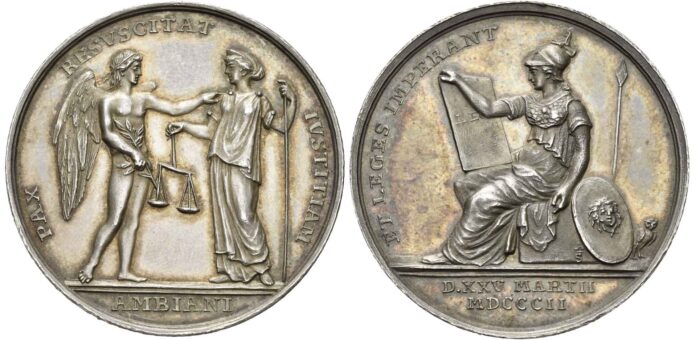The major new acquisition “Ius in nummis: The Thomas Würtenberger Collection” provides both the occasion and material for this special exhibition by the Münzkabinett at the Bode-Museum.
The breadth of Tomas Würtenberger’s “Ius in nummis”collection is unique. Gathered together over half a century, it comprises more than 3,000 objects – primarily medallions and a smaller number of coins – focussing on the modern legal history of Western Europe, though with an increasingly global perspective in more recent years. As such, every object in the collection opens a window onto a piece of legal history.
Iūs, iūris means, among other things, “law”. Rules and laws provide order and have been a pervasive part of the everyday lives of human beings for millennia. And yet, the terms law and justice describe a dynamic field of contested activity. Legal actions and conceptions issue from individuals. Whether or not a state is guided by the rule of law, by a constitution or an unjust and capricious system of domination are consequences of the value systems people live by. Legal historians draw on a diverse range of sources to explore events such as the passing of legislation and legal acts, but also the influence of individual legal personalities and cultures.
Nummus -ī refers to coins and currency, but it has also come to refer to a related medium: the medallion. For legal archaeology, this medium provides a fertile primary source. From Moses through to the declaration of human rights, the art of medallions opens up a vast panorama of how the law has been visually framed throughout history.
The exhibition Ius in nummis: A Survey of the Collection in Twelve Parts
As the new custodians of the Würtenberger collection, the Münzkabinett has set itself the task of preserving the artefacts that comprise it and making them accessible to the public. Since 2020, staff have been working to digitally document the collection, which is the first step in systematically exploring this valuable cultural asset. The exhibition, catalogue and accompanying programme all have their fingers on the pulse of current research into this important new acquisition. First up, the overarching theme of this special collection “Ius in nummis” will be presented. Moving forward though, the project will also explore the potential forms of knowledge that numismatic sources can provide for the history of the law.
The numismatic objects that have been preserved throughout history provide a near complete picture of a cultural practice that has become a central part of human life. Depending on their materiality and number, these objects can be highly exclusive or common to everybody, visually capturing a plethora of people, objects and events. As mobile and lasting media, medallions can move from person to person, transcending political, religious and cultural barriers. And sometimes, the surfaces of these handheld monuments tell fascinating stories about the histories of these objects.
The exhibition provides audiences with a framework to help them navigate their way through this thematically, geographically, and temporally diverse collection. Each of the twelve sections of the show focus on different themes, and together provide an overview of the collection. From symbols, individuals, structures, institutions, all the way through to revolutions and constitutional questions, medallions always provide points of comparison with current issues.
Contemporary Perspectives on Issues of Law and Justice
To accompany the exhibition, the Berlin Medailleurkreis has put together a special edition of medallions for Ius in nummis. Contemporary perspectives on the major questions and minutiae of the law and justice comment on the themes of the exhibition through medallions. Both the Berliner Berliner Medailleurkreis and members of the Deutsche Gesellschaft für Medaillenkunst have contributed to this special feature.
Exhibition Publication
A catalogue will be published to accompany the exhibition.
A special exhibition by the Münzkabinett of the Staatliche Museen zu Berlin
Source : Museen zu Berlin






